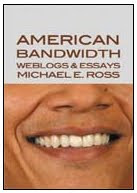If you want an idea of how fast and how slowly this nation can change on the ticklish issue of race, consider the case of two racist mushwits, an assassination plot, a grand jury and the desire for a fair and impartial jury. But maybe not like you think.

Daniel Cowart, 20, of Bells, Tenn., and Paul Schlesselman, 18, of Helena-West Helena, Ark., were recently charged in Memphis with an assassination plot against President-elect Barack Obama. The authorities told The Associated Press that the two white supremacists were planning a robbery and killing spree in which dozens of African Americans would be murdered, apparently indiscriminately. The assassination of Obama was to be their triumphal act of savagery.
Cowart and Schlesselman were charged with threatening a presidential candidate and taking firearms across state lines to commit crimes.
But The AP reported Thursday that Cowart is seeking to have his indictment dismissed, claiming that the federal grand jury leveling the charges has … too many black people on it for him to get a fair trial.
According to AP, Cowart's lawyer, Joe Byrd, filed a petition Thursday seeking to have Cowart’s indictment dismissed, arguing that the 23-member grand jury that brought the indictment only had two white members, and therefore couldn’t have been fair and impartial.
◊ ◊ ◊
Never mind the fact that black American service on grand juries is a relatively rare thing in the first place. The Cowart case isn’t the first time that the historically more common equation of black defendant/white grand jury has been turned on its ear.
In April 1998, the U.S. Supreme Court ruled (in Campbell v. Louisiana) that white criminal defendants indicted by grand juries from which black people had been excluded could fight the constitutionality of the indictment, on the basis of those juries not representing the defendant or his community.

That ruling largely hinged on the Court's analysis of white defendant Terry Campbell's claim of a violation of the right to equal protection guaranteed by the Equal Protection Clause of the 14th Amendment — essentially, Campbell’s right to stand in the role of black people excluded from the jury by asserting a violation of their right to equal protection.
A 1991 SCOTUS decision, Powers v. Ohio, held that a white defendant could challenge the exclusion of black jurors from the trial jury.
But the current case may be the first in which an avowed white supremacist —a man whom authorities believe had vast racial murder on his mind — tried to avail himself of protections more frequently sought by the racially disenfranchised.
There’s inescapable irony in a white supremacist mounting the same jury-of-one’s-peers argument that blacks and other minorities have employed to counter the historical racially one-sided dynamics of grand jury composition. What colossal nerve! Who does this guy think he is — an African American?
On the one hand, it’s an amusing turnabout-as-fair-play situation. But on the other, it’s a perversely reassuring validation of our justice system. White supremacist pursues dismissal of an indictment — on racial grounds. You don’t hear of that happening everyday, now, do you?
-----
Image credits: Cowart: Unknown (possibly from his MySpace page). Supreme Court Building: Duncan Lock (Dflock), republished under GNU Free Documentation License v1.2 or later.






No comments:
Post a Comment